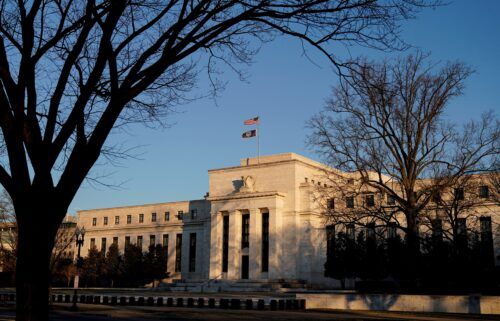Consumer price inflation fell to 3.2% last month, in welcome news for US households and the Fed
By Alicia Wallace, CNN
Minneapolis (CNN) — First, the bad news: Prices continue to rise. Now, the good news: They’re doing so at a rate not seen in two years.
The Consumer Price Index rose 3.2% for the 12 months that ended in October, down from 3.7% in September, and clocking in at the lowest annual rate since March 2021, according to Bureau of Labor Statistics data released Tuesday.
US consumer price inflation cooled more than expected — after rising for the last two months — sending US stocks sharply higher and providing a touch more solace to Americans who have dealt with painfully high prices the past two years.
The Dow was up by more than 500 points by mid-morning, or 1.5%. The S&P 500 gained 2%, on pace for its best day since January; and the Nasdaq Composite added 2.3%, on track for its best day since April.
On a monthly basis, prices were unchanged for the first time since July 2022. A month before, they shot up 0.4% as gas and rent costs added upward pressure.
Economists anticipated a 0.1% monthly increase and a 3.3% year-over-year gain, according to Refinitiv consensus estimates.
In October, energy prices dropped off significantly; however, those declines were offset by the continued rise of shelter costs, according to the report. However, shelter prices (which measure rental leases and the implicit rental value of owner-occupied properties) increased at 0.3% for the month, down considerably from the 0.6% spike in September.
Food prices, including those at the grocery store and at restaurants, saw a slight acceleration in September. Annual inflation across those categories dipped further, however, and is now at levels not seen since 2021. Annual food inflation was 3.3%, the lowest since June 2021; food at home dropped to 2.1%, also the lowest since June 2021; and food away from home fell to 5.4%, the lowest since November 2021.
There also was positive news on the underlying inflation front.
Core CPI, which excludes the more volatile food and energy categories, climbed 0.2% monthly, bringing the annual increase to 4%, which is the lowest yearly increase since September 2021.
It cooled from the prior month, when core CPI rose 0.2% monthly and 4.1% annually, and beat expectations for a 0.3% monthly increase and a 4.1% annual gain.
It’s ‘progress’ — but inflation is still too high
The slowdown in both headline and core inflation are encouraging developments for the Federal Reserve, which is in the throes of a monetary tightening and rate-hiking campaign to slow demand and cool inflation.
“There’s been progress here on getting inflation to slow down, but it’s just that: It’s progress,” Michael Pugliese, a senior economist at Wells Fargo, told CNN Business. “I don’t think we’re at a point yet where I would characterize inflation as low or even moderate.”
The Fed closely monitors core inflation and is specifically looking for the core Personal Consumption Expenditures price index (a separate inflation gauge released by the Commerce Department) to hit 2%. In September, the annual core PCE index increased 3.7%.
“I don’t anticipate them coming out and saying, ‘Mission accomplished’ [at the Fed policymaking meeting] in December,” Pugliese said, noting he expects no change in interest rates one direction or the other. “But I do think as we start to look toward 2024, the discussion is going to be more about how long this policy stays this restrictive and less about how much more restrictive does it need to become.”
After the CPI data was released, Richmond Federal Reserve President Thomas Barkin said Tuesday at an event: “I fear more needs to happen to curb demand and inflation,” adding that he is not convinced inflation is on a “smooth path” towards the Fed’s 2% target. But he noted that progress has been made.
Running up against spending limits
In the meantime, Americans will continue to face the dual pressures of high inflation and high interest rates.
“Inflation can be fast and slowing,” Pugliese said. “A car could be going 100 miles per hour and then go to 80. It’s slowing down, but it’s still going fast.”
Consumers have remained relatively resilient in the face of persistent inflation, spending more than economists thought and keeping the economy growing well above expectations.
But that has come at a cost: Americans are piling up record credit card debt and more and more people are starting to fall behind on those payments.
“As long as US households continue to spend, that demand will prevent inflationary fires from being doused,” said Kurt Rankin, senior economist at PNC Financial Services.
The October CPI report gave some hints that a slowdown in discretionary spending is afoot, he noted.
Inflation in recreation categories slowed to 0.1% for the month, down from 0.4% in September. On an annual basis, those prices are now up 3.2%, which is the lowest since November 2021.
“Thus, the October slowdown in recreation price growth offers hope that demand-side drivers of inflation will fall in line with the economic realities of households bumping up against their spending limits,” Rankin noted.
— CNN’s Krystal Hur and Elisabeth Buchwald contributed to this report.
The-CNN-Wire
™ & © 2023 Cable News Network, Inc., a Warner Bros. Discovery Company. All rights reserved.

